Top News
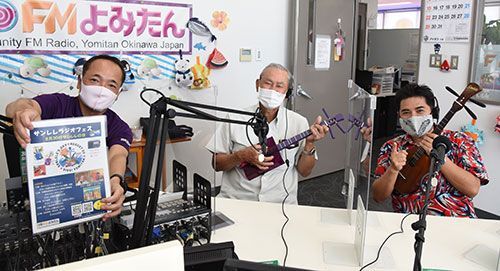
September 2, 2021 Ryukyu Shimpo
August 30 was Sanlele Day in Okinawa. FM Yomitan, Yomitan Village’s community FM radio station (President Tomoharu Nakasone), broadcasted a special program titled Sanlele Radio Festival. Sanlele (a blend of sanshin and ukulele) is a musical instrument engineered by Sanshin Kobo Machidaya, located in Takashibo, Yomitan Village. Guest personalities appeared on different segments to promote the novel instrument and shared its appeal and the secret story of its genesis.
The 11 am program, Yuntanja Deban Desuyo!, welcomed Yomitan Village Mayor Denjitsu Ishimine and Alberto Shiroma of the Latin music band Diamantes. Alberto, the inventor of the sanlele, said, “this instrument makes you want to write music. It stands up to water, which is fitting for Uchinanchus–we stand up to any situation.”
A star-studded group performed for the first time the song Alberto composed for Sanlele Day, titled Sing on the Sanlele—Okinawa Do Mi Fa no Uta, with Ayano Kinjo of the pop duo Kiroro on the piano, guitarist Yoshiaki Nagamine on the guitar, and Kiyosaku of MONGOL800 on the bass, and vocals provided by Elvis Higa. Morio Higaonna provided the lyrics.
The song is a pop song written in the Ryukyuan music scale, with Uchinaguchi (Okinawan dialect) lyrics. Mayor Ishimine said after listening to the song, “Okinawans were faced with hardship during the COVID pandemic, but I’m feeling hopeful. I wish to organize a wonderful festival on Sanlele Day next year.”
Behind-the-scenes footage of the making of the song and the Sanlele Radio Festival are available on YouTube.
(English translation by T&CT and Monica Shingaki)
Go to Japanese
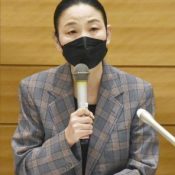
September 2, 2021 Ryukyu Shimpo
Sugok Shin and other plaintiffs were interviewed in Tokyo on September 1 regarding the Tokyo District Court’s decision in their defamation lawsuit concerning the television program News Girls (Nyūsu Joshi), which picked up the topic of protest activities against U.S. military helipad construction in the surroundings of Takae, Higashi Village in Okinawa Prefecture. Shin called the decision that the defendant must publish a public apology “ground-breaking”, and, looking forward, she said, “In the next stage, we must fight on.”
In her interview, Shin commented on this program by DHC Television, saying, “It was malicious fake news ridiculing the peace movement.” The program that sparked the lawsuit was broadcast in January 2017. In the program, Shin was referred to as a “black curtain behind the opposition movement”, and citizens opposing helipad construction were referred to as “terrorists”. Shin suffered damage from not-factually-based slander that was spread on the internet, including on social networking services. Looking back, she said, “It was merciless.”
Shin’s rigid countenance did not falter when the decision was handed down, but she choked up during her interview. She explained her state of mind, saying, “I had the thought ‘what will happen if I lose?’”
The team of lawyers commented that the decision by the court for “5,500,000 yen” (approximately $50,000) to be paid in damages and ordering the publication of an apology was the best-case scenario.
The lawyer Katsuhiko Tsukuda said, “The damages are extremely high compared to other judicial precedents set. It is my understanding that the court’s message takes into consideration the severity of harm that Shin suffered in that it is also exceptional that a public apology was awarded.”
Shin alluded to the fact that the day the decision was handed down overlapped with the anniversary of the Great Kanto Earthquake as well as a massacre of many Korean people that was instigated on the basis of misinformation.
She brought up the danger of being influenced by unreliable information, saying, “The incitement led to many Korean people being killed. Those who created the program are also in the wrong, but the people who incited [the killing] were far more immoral.”
In the lawsuit, the request concerning Yukihiro Hasegawa and the request that distribution of the program be stopped were not approved. Shin expressed her intention to appeal to a higher court to also request a judicial decision on these matters.
She said, “I want to show [people] what is happening in Okinawa”, bringing up the current situations in Okinawa including that helipad construction in Takae is still being forced through and construction of the Futenma Replacement Facility in Henoko, Nago City is also moving forward. She also stated, “Everyone is turning a blind eye to this cruelty. Each one of us should turn our attention to it earnestly.”
(English translation by T&CT and Erin Jones)
Go to Japanese
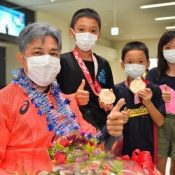
August 31 2021 Ryukyu Shimpo
Hirokazu Ueyonabaru, 50, – SMBC Nikko Securities Inc. – who won the bronze medal in both the 400-meter and 1,500-meter men’s T52 wheelchair race, returned to Okinawa the evening of August 30, landing at Naha airport. Seeing the people who came out to met him, he said “It was a sigh of relief (to win a medal)” beaming a big smile.
That morning he contended with press conferences in Tokyo before heading home. He showed off his two bronze medals, holding them up from his neck in the airport lobby, saying “I could not have done it without all the cheers from everyone. My goal was to win a medal, but even I was surprised to win them,” displaying his sense of accomplishment. In response to a reporter’s question about future Paralympics, Ueyonabaru spoke of his goals, “Definitely Paris and the one after that. Because I have not won a gold medal yet.”
The fan club did not have a ceremony at the airport, but supporters and their kids came out to meet him. Yuuto Kawabata – a fifth grader at Takahara Elementary – who exchanged a paper medal and got to wear the bronze medals said, “It was really heavy, but I’m happy,” while gazing at the real medal.
(English translation by T&CT and Sam Grieb)
Go to Japanese
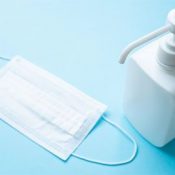
August 26, 2021 Ryukyu Shimpo
Tokyo – Takaji Wakita, the chairman of an advisory board of experts assembled to advise the Ministry of Health, Labour and Welfare (MHLW) on policies to combat the COVID-19 pandemic, indicated on August 25 that Okinawa’s strained healthcare system as it battles with the spread of the coronavirus puts it in a situation that is, “the toughest of all 47 prefectures in Japan.”
According to data released by the advisory board, Okinawa’s “Hospital bed occupancy rate” was at 83.9%, and “Critical care bed occupancy rate” was at 88.2% (both figures as of August 23), and that it was “trending towards 90%.”
Regarding the necessity of establishing a special ward to treat COVID-19 patients, they indicated a cautious stance, noting “the situation is different from region to region,” and that the existing hospital beds and medical resources should continue to be utilized.
The committee explained for the spread of the disease among children, “There are many cases of infection clusters happen at school, and then the disease is brought home.” They indicated that they are not in favor of cancelling school for elementary and middle schools, and commented, “We want [schools] to look into postponing or canceling club activities and sports festivals.”
(English translation by T&CT and Sam Grieb)
Go to Japanese
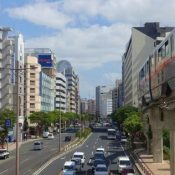
August 26, 2021 Ryukyu Shimpo
On August 25, Tokyo-based Daito Trust Construction Company, led by President Katsuma Kobayashi, published its ranking of the most livable places in Japan and places people want to move to. Ranked by municipality, Naha City ranked 2nd in the list of places people want to move to. Okinawa Prefecture came in 4th in the same category ranked by prefecture. The Prefecture also ranked 6th in the “most livable” category, reflecting its popularity and residential satisfaction.
The rankings were derived from 708,700 survey responses. The livability category was ranked based on results from a three-year survey conducted between 2019-2021, while the “places people want to move to” survey was conducted this March.
In the “places people want to move to” category, Naha City moved up a spot from the previous year. Fukuoka City maintained 1st place from last year, while Yokohama City dropped to 3rd from 2nd place. Survey respondents said about Naha City: “The food is delicious and the local people seem nice,” and, “[Okinawa] has a warm climate and plenty of commercial services available.”
As for the “most livable places” ranking, Daito measures livability through a comprehensive evaluation of eight factors including residential convenience, ease of transportation, and government services.
Okinawa came in 6th in the “livability” ranking by prefecture, moving up three places from 9th place last year. The prefecture received high marks for residential convenience (2nd) and friendliness (2nd), etc. Tokyo ranked 1st on the list, followed by Hyogo and Fukuoka Prefectures. By municipality, Chatan ranked 53rd in “livability,” the highest in Okinawa. Nagakute City in Aichi Prefecture ranked 1st place on the list.
(English translation by T&CT and Monica Shingaki)
Go to Japanese

August 27, 2021 Ryukyu Shimpo
In response to an incident in which water contaminated with polyfluoroalkyl substances (PFAS) that had been stored on Futenma Air Station was treated and released into the sewers by the U.S. Marine Corps, on August 26 Ginowan citizens rallied in front of a gate to Camp Zukeran (Camp Foster) in Kitanakagusuku Village and raised their voices in protest of the incident. About 10 citizens held placards with criticisms of the U.S. military’s handling of this matter, including “Don’t let PFAS flow” and “Don’t discriminate against Okinawa.” Meanwhile, farmers who work in the vicinity of the airfield are concerned that there could be damage to their crops. It is a source of disappointment for local residents that the U.S. military spares no consideration for them.
Hatsuko Goya of the citizens’ group Ginowan Clean Water Association said, “I was surprised to hear [about the release]. We must express that ‘citizens are angry’ right away. Pollution from the military bases is difficult for citizens to watch happen. It’s frightening.”
Isao Tobaru of the Ginowan City Assembly angrily stated, “It is inexcusable that the release was done unilaterally. ‘It’s ok if it’s diluted’ does not ring true. If we excuse it once, the U.S. military is likely to continue such releases hereafter.”
There was also an incident in June in which water contaminated with PFAS flowed off from the U.S. Army Oil Storage Facility in Uruma City. Hidekazu Miyagi, the secretary general of the Uruma City Island-Wide Council, also participated in the protest rally. He stated, “There was an outflow of contaminated water in Uruma City. Don’t you think the release into the sewers without any hesitation, as with this time, is because Okinawa is perceived as a colony?”
(English translation by T&CT and Erin Jones)
Go to Japanese
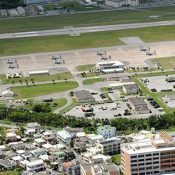
August 26, 2021 Ryukyu Shimpo
On the morning of August 26, the U.S. Marines in Okinawa announced that they have begun disposing of polluted water containing organofluorine compounds (PFAS) in the public sewage system after the water has been treated. They had been storing the water at MCAS Futenma in Ginowan. The marines say that after treatment, the PFOS and PFOA content of the water is less than the benchmark for drinking water in Japan (50 nanograms per liter).
According to the announcement, the U.S. Marines will remove PFAS from the water using a treatment device and then drain the treated water into the sewage system. The treated water contains 2.7 nanograms of PFOS and PFOA per one liter of water, and is “twenty times cleaner than Japan’s benchmark.” They say that the PFAS removed from the water will be transported out of Okinawa and incinerated at a facility approved by the Japanese government.
At the press release on August 26, the spokesperson for the marines said, “we will create a safer and cleaner environment for everyone.”
PFOS and PFOA are designated as Class I Specified Chemical Substances under the Chemical Substances Control Law, so new manufacture, import, or use of PFOS and PFOA in Japan is forbidden. The substances do not exist in nature, are difficult to break down, and remain in the environment for a long time. Even if treating the water reduces the concentration of PFOS and PFOA per liter, if large volumes of the treated water are disposed of, ultimately a large quantity of PFOS and PFOA will build up in the environment.
The Ginowan City Council has unanimously passed a resolution and a document calling for an end to the disposal of polluted water containing PFOS and the like using the public sewage system or the rivers.
(English translation by T&CT and Ellen Huntley)
Go to Japanese
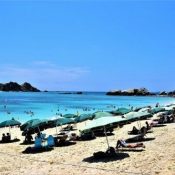
August 23, 2021 Ryukyu Shimpo
By Hideaki Yoneda
Tokashiki – Paying no heed to the coronavirus pandemic, large numbers of tourists have come to Tokashiki Island, filling the beaches for some fun in the sand, sun, and ocean water.
Despite a typhoon cancelling ferries connecting Tokashiki and Naha and moving up the timeframe for some ships departing the island, since August 9 a ferry with a capacity of 450 passengers and a high-speed ferry that can carry 200 have continued to bring tourists to the island at over half-full capacity.
In the village of Tokashiki however, since receiving the emergency declaration from Okinawa prefecture they have been asking both village residents and tourists in the village to not venture outside for anything unnecessary or urgent, have issued a travel advisory, have asked people to refrain from coming and going to the village, and have asked that people take thorough coronavirus prevention measures.
One man, 40, who came to Tokashiki from Tokyo to enjoy swimming in the ocean with his family said, “We came after being pestered by our children. We were down after not being able to see the Olympics due to the coronavirus, and needed to do something to relieve some of the stress.”
(English translation by T&CT and Sam Grieb)
Go to Japanese

August 20, 2021 Ryukyu Shimpo
On August 19, seven parties, including the prefectural government and the University of the Ryukyus, entered a partnership agreement to preserve and manage the World Natural Heritage sites of northern Okinawa and Iriomote Island. The partnership will advance long-term research and human resources training in preservation management. Governor Denny Tamaki said at the online signing ceremony, “we will be putting together a budget for the project.”
Other signees of the partnership agreement are the Okinawa Institute of Science and Technology Graduate University (OIST); the National Institute for Environmental Studies (NIES); Forestry and Forest Product Research Institute, Kyushu Research Center; Kyushu [sic] Regional Forest Office, Okinawa Bureau; and the Ministry of the Environment, Okinawa Amami Natural Environment Office. Each organization has conducted its own nature and culture research for some time. Their combined scientific expertise will aid in maintaining the World Heritage sites and monitoring the registered site reports submitted to the United Nations Educational, Scientific and Cultural Organization (UNESCO).
Mutsumi Nishida, President of the University of the Ryukyus, said, “The University has wide-ranging research experiences in the areas of nature, culture, tourism, and World Natural Heritage sites. I look forward to sending in some of our students to contribute to this partnership.” Hiroya Yamano, Regional Director of the National Institute for Environmental Studies, and Shinichiro Tohmura, Director of the Forestry and Forest Products Research Institute Kyushu Branch, also shared their enthusiasm for developing young researchers for the project.
(English translation by T&CT and Monica Shingaki)
Go to Japanese
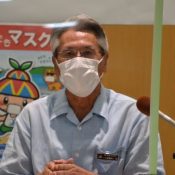
August 19, 2021 Ryukyu Shimpo
Miyakojima Mayor Kazuyuki Zakimi held a press conference at the Miyakojima City Hall August 18, where he warned both tourists and people looking to return home to the island that the area had become “one of the world’s worst hot zones” of COVID-19, strongly requesting that they not come to the island.
According to sources such as city officials, from the start of August through the 18th, there have been 440 confirmed cases. Being “in danger of the healthcare system collapsing,” the cases are nearly double the number confirmed during the third wave of the disease back in January. The Miyako Prefectural Hospital stopped accepting general outpatients August 16, and the healthcare system as a whole is under stress.
In the past week, the new confirmed cases per 100,000 people was at 444.85, 1.5 times Okinawa (310.32) which is the worst for a prefecture in Japan, and nearly double the rate in Tokyo (226.83). It is higher than Malaysia (403.4), where their government’s cabinet resigned en masse over their failed coronavirus policies.
According to Miyakojima, infections are high among young adults in their 20’s and 30’s who work in the hospitality, food, or construction industry. Zakimi warned, “infections from restaurants who are not honoring the ban on serving alcoholic beverages, and tourism areas have put us in a dire situation.”
He added, “One of the sources of infections are people carrying the virus who come to the island from mainland Japan.”
(English translation by T&CT and Sam Grieb)
Go to Japanese

August 20, 2021 Ryukyu Shimpo
Concerning an incident on August 12 in which components of a U.S. Marine Corps MV-22 Osprey transport aircraft fell therefrom, the Okinawa Defense Bureau (ODB) on August 19 clarified that one of the components in question was a panel exceeding one meter in length. This was an amendment of the explanation given the day after the incident, on August 13, when the component was described as being approximately 35 centimeters vertically, and approximately 45 centimeters horizontally. Okinawa Deputy Governor Kiichiro Jahana called Ambassador in charge of Okinawan Affairs Naofumi Hashimoto of the Ministry of Foreign Affairs (MOFA) and Director Isao Ono of the ODB to the Prefectural Office on August 19 in order to lodge an objection about the fallen components. Deputy Governor Jahana has requested preventative measures, and requested that flights of MV-22 Osprey be suspended until the cause of the incident is investigated.
A spokesperson for the U.S. Marine Corps stationed in Okinawa explained that the initial report was conjecture, and that an amendment was issued as soon as the actual size of the panel was realized. The ODB received information pertaining to this incident from the United States on August 18 and conveyed this information to the Okinawa Prefectural Government (OPG) and relevant municipalities on the same day, and on August 19 an ODB spokesperson provided an explanation to the media.
According to the ODB, the size of the fallen panel was approximately 109 centimeters in length, 68 centimeters in width, 1.9 centimeters thick, and weighed 1.8 kilograms. This panel had been attached to a roof portion of the cockpit. On the same day a covering called a “blade fairing”, which had been attached to the propeller engine cover on the right side of the aircraft, also fell. The blade fairing has a length and width of 43 centimeters and a thickness of 0.3 centimeters, but its weight is unknown. Initially, the blade faring was announced as being about 23 centimeters long and about 8 centimeters wide.
On August 19, when lodging his objection with Ambassador Hashimoto and Director Isao Ono, Deputy Governor Jahana said that such an incident “could lead to a serious accident, and causes apprehension for the residents in the area as well as prefectural citizens. It is outrageous that training with the same type of aircraft was conducted the next day despite there being no investigation into the cause [of the incident].” Jahana also requested the withdrawal of the Osprey and the expedited closure and return of Futenma Air Station. He pointed out that more incidents occur during periods when training is conducted frequently, and said that he would like to ask for training to be suspended and for a complete inspection of the aircraft. He also mentioned wishing that the Japanese government would step up a little more and take a strong stance with the United States.
(English translation by T&CT and Erin Jones)
Go to Japanese











 Webcam(Kokusai Street)
Webcam(Kokusai Street)


